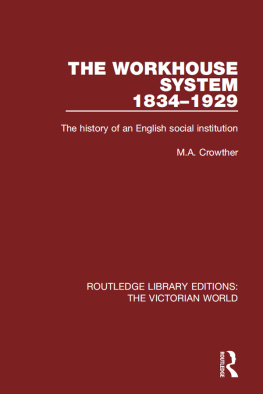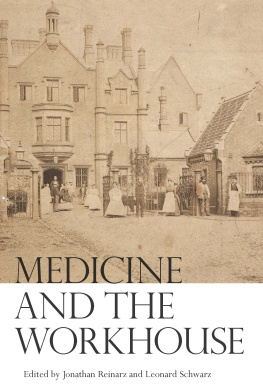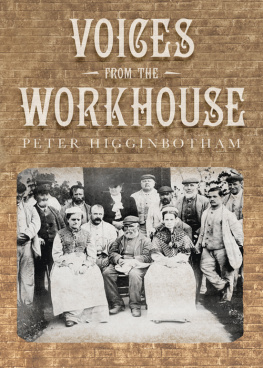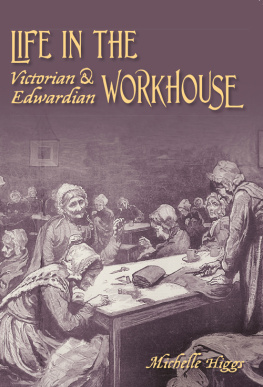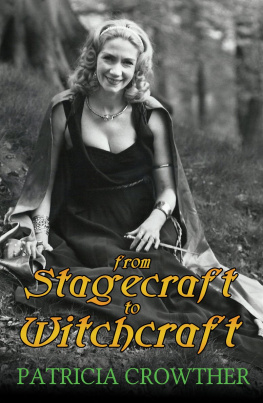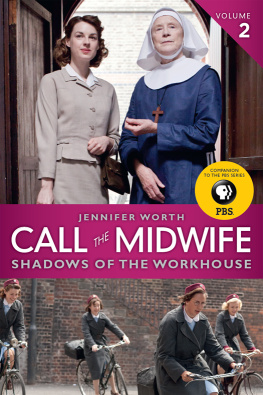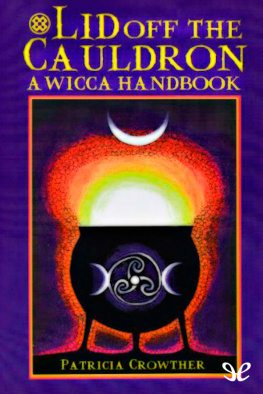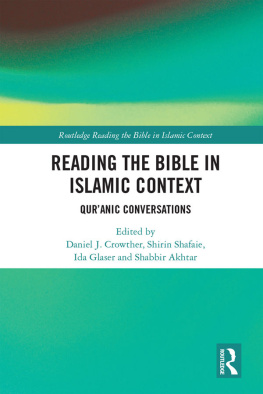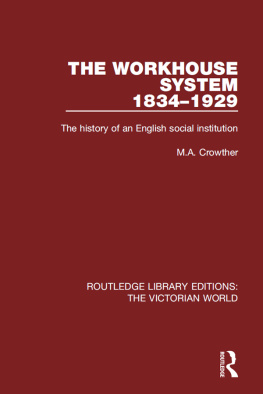ROUTLEDGE LIBRARY EDITIONS:
THE VICTORIAN WORLD
Volume 11
THE WORKHOUSE SYSTEM
18341929
THE WORKHOUSE SYSTEM
18341929
The history of an English social institution
M.A. CROWTHER
First published in 1981 by Batsford Academic and Educational Ltd
First published as a University Paperback in 1983 by Methuen & Co. Ltd
This edition first published in 2016
by Routledge
2 Park Square, Milton Park, Abingdon, Oxon OX14 4RN
and by Routledge
711 Third Avenue, New York, NY 10017
Routledge is an imprint of the Taylor & Francis Group, an informa business
1981 M. A. Crowther
All rights reserved. No part of this book may be reprinted or reproduced or utilised in any form or by any electronic, mechanical, or other means, now known or hereafter invented, including photocopying and recording, or in any information storage or retrieval system, without permission in writing from the publishers.
Trademark notice: Product or corporate names may be trademarks or registered trademarks, and are used only for identification and explanation without intent to infringe.
British Library Cataloguing in Publication Data
A catalogue record for this book is available from the British Library
ISBN: 978-1-138-66565-1 (Set)
ISBN: 978-1-315-61965-1 (Set) (ebk)
ISBN: 978-1-138-64743-5 (Volume 11) (hbk)
ISBN: 978-1-138-64746-6 (Volume 11) (pbk)
ISBN: 978-1-315-62703-8 (Volume 11) (ebk)
Publishers Note
The publisher has gone to great lengths to ensure the quality of this reprint but points out that some imperfections in the original copies may be apparent.
Disclaimer
The publisher has made every effort to trace copyright holders and would welcome correspondence from those they have been unable to trace.
The
Workhouse
System
18341929
The history of an English social institution
M.A. CROWTHER
Methuen
DEDICATION
In memory of
WILLIAM BROUGHTON WORDEN
AND
PROFESSOR JOHN PARKER
First published in 1981 by Batsford Academic and Educational Ltd
an imprint of B. T. Batsford Ltd
First published as a University Paperback in 1983 by
Methuen & Co. Ltd
11 New Fetter Lane, London EC4P 4EE
1981 M. A. Crowther
Printed in Great Britain at the
University Press, Cambridge
All rights reserved. No part of this book may be reprinted or reproduced or utilized in any form or by any electronic, mechanical or other means, now known or hereafter invented, including photocopying and recording, or in any information storage or retrieval system, without permission in writing from the publishers.
British Library Cataloguing in Publication Data
Crowther, M. A.
The workhouse system, 18341929.(University paperback 818).
1. WorkhousesEngland
I. Title
362.5850942 HV8749.G7
ISBN 0-416-36090-4
Contents
Figures in the text
For permission to consult and to quote from manuscript sources, I should like to thank the following: the British Library, for John Burns MSS; the University of Birmingham, for Chamberlain family papers; the Public Record Office for Ministry of Health records; Kent County Council; The Greater London Council; The Principal Archivist, Nottinghamshire Record Office. I am grateful to the archivists and librarians in these and the other institutions who have helped me, but I should like to mention in particular Miss E. Melling of the Kent County Archives and Miss E.L. Plincke of Bromley Public Library.
For permission to quote at length from copyright material I am indebted to the following: Mrs Margaret Asher for Richard Ashers Talking Sense (Pitman Medical); Andre Deutsch Ltd., for Bella Aronovitchs Give it Time: An Experience of Hospital; Professor Peter Townsend for his The Last Refuge (Routledge & Kegan Paul). I should also like to thank the British Federation of University Women and the Trustees of the Theodora Bosanquet Bursary for enabling me to spend some time in London for research purposes.
Many colleagues have contributed directly and indirectly to the writing of this book, but I should like to mention in particular Professors R.H. Campbell, S.G. Checkland, M. Jeanne Peterson and M.I. Thomis, who assisted me with their expertise in specific areas. Dr Esther Welbourn patiently answered my queries on medical matters. Karl Figlio, Rosalind Hargreaves, Ludmilla Jordanova, Gillian Sutherland and Pat Thane all helped to expand my field of vision. I hope they will accept the result charitably.
To Dr Anne Digby, a fellow long-term inmate of the pauper palaces, I owe a special debt for her meticulous criticism and encouragement.
Add. MSS Additional Manuscripts, British Library
BMJBritish Medical Journal
Ec. Hist. Rev.Economic History Review
GLC Greater London Record Office, County Hall, London
HJ Historical Journal
HMSO Her Majestys Stationery Office
KCA Kent County Archives, County Hall, Maidstone
LGB Local Government Board
MH Ministry of Health Records, Public Record Office
MoH The Ministry of Health
NPLOA National Poor Law Officers Association
NRO Nottinghamshire Record Office, County House, Nottingham
PLB Poor Law Board
PLC Poor Law Commission
PP Parliamentary Papers, House of Commons
The names of the authorities and officials responsible for Poor Law administration changed several times, and the following guide may be useful:
From 1834 until 1847, the Poor Law was administered by three Poor Law Commissioners, assisted by their Secretary (Edwin Chadwick), and a small staff of about nine clerks. Assistant Commissioners had the duty of local inspection. The Poor Law Commission was not directly represented in Parliament, and had no official spokesman; after the scandal of Andover workhouse in 1845, the Commission was fatally weakened.
From 1847 until 1871 the Poor Law Board was the responsible authority, having been created by an Act of Parliament to replace the Commissioners. The Board was a cypher and never met, but its president was a member of Parliament. The chief executive officer was the civil servant who was permanent Secretary to the Poor Law Board, but as political convenience dictated these appointments, much of the actual administration during the Boards life was done by one of its senior clerks, Sir Hugh Owen (sen.) The titles of the Assistant Commissioners changed to Poor Law Inspectors. The size of the Inspectorate fluctuated between ten and 20, depending on the financial policies of the time; it became slightly more specialized in this period, with the appointment of two Inspectors with special responsibility for Poor Law schools.
From 1871 until 1919 the responsible authority was the Local Government Board, created to handle a wide range of affairs, particularly public health. Poor Law administration became a department of the Board, whose president was usually a member of the Cabinet. At first there were three joint permanent secretaries to the Board, but these were soon replaced by a single secretary, who was the main driving force of the administration. The Inspectors were now called


